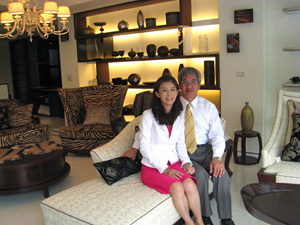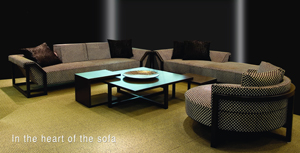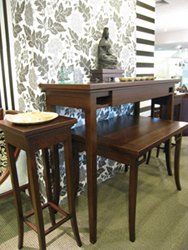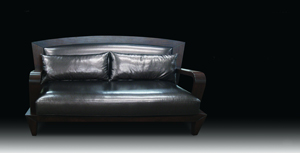Chen Pin Mixes Classical and Modern in Furniture Making
2009/10/07 | By Judy Li
One of the few who have survived in the making of classical, traditional wooden furnishings in Taiwan is Chen Pin Furniture & Design Co. Although just a decade old, Chen Pin shows promise as it is owned, operated by a couple who are formally trained interior decorators. With experience in serving high-end clients and an aptitude for developing design-oriented furniture, as well as willingness to turn out tailor-made items and offer professional interior decor services, the husband-wife team has left the toughest goings behind.
Tiger Lin and Hsu Ching-ching make up the designer couple who established Chen Pin about 10 years ago. “Before setting up the company, my husband and I worked mostly in interior decoration since we are professionals, a trade that has been good to us whereby we’ve built up a sizable client base who are also friends,” Hsu says.
“Our clients come from mainly the peak of the consumer pyramid, who prefer to furnish their premium apartments or luxury homes with unique, top-end pieces and materials. So my husband and I often traveled abroad to find rare upholstery materials, precious furnishings and high-end accessories to cater to such demands,” she states.

Accidentally Inspired
The couple were accidentally inspired to start up their own furniture company in 1998 when they flew to Milan for an international furniture fair. On the way to the trade show, the couple saw a damaged wooden classical Chinese chair from the Ching Dynasty (1644-1911) in a museum.
“We were awestruck that such an ordinary Chinese-style chair would be displayed in a museum in Milan, which inspired me to produce such classical furnishings to help perpetuate Chinese culture,” Lin recalls. “After coming back from Italy, my wife and I began preparing to establish our furniture firm to realize our dream.”
“Frankly, it’s really painstaking to produce such furniture. We came across numerous difficulties and frustrations initially since traditional wooden Chinese furniture is rare today. Also we insist on using tenon-jointing in manufacturing, a virtually lost technique nowadays, so it is hard to find capable carpenters,” Hsu explains.
“Without using hardware, tenon-jointing is a traditional carpentry technique used mostly by artisans of yore. After ample legwork, we finally tracked down some artisans in the rural community of Tahsi in Taoyuan county, northern Taiwan, who still use such jointing technique to make round wooden tables mainly for worshipping gods and honoring ancestors,” Hsu points out.

Uphill Battle
“To be close to the skilled labor, we decided in 2000 to set up a furniture plant in Tahsi,” Lin continues. “Not to be left behind by world trends, we ask the artisans to blend classical and contemporary styling. However, some of them could not adjust and left us. We have had to try hard to communicate what we want in terms of style as we continue to look for capable carpenters. It was an uphill battle in the early years, not only to find experienced, skilled workers, but also to tap markets.”
“We lost around NT$500,000-600,000 (US$151,515-181,818) monthly just from scrapping flawed pieces during the first couple years,” Lin confesses. “Besides, it usually takes at least one or two years to train a new artisan to be able to appreciate, express modern flavor in classical Chinese furniture.”
“In addition to skill-training, we also have to be keen material buyers,” Lin points out. “We use mostly teak imported from Africa and Myanmar, where the supply is sometimes unreliable. So we stock sizable inventory of teak logs usually, purchasing each time at least NT$3-4 million (US$90,909-121,212) to avoid being caught short.”
“Normally a large log has to be dried for more than a year before being ready for furniture making,” Lin says. “Keeping a large inventory of logs also ties up capital, which incurs opportunity cost. This coupled with difficulties in labor recruitment, as well as overcoming challenges in marketing tenon-joint furniture that costs much more than conventional counterparts, make running our business especially harrowing.”

Labor-of-love
Nevertheless, the couple sees the rigors of entrepreneurship almost a labor-of-love. “We love developing classical Chinese wood furniture because the satisfaction derived is inimitable, partly for wood is an organic material that changes with environmental conditions,” Hsu notes. “Wood shrinks or swells depending on humidity, which influences manufacture of furniture. An experienced carpenter can tell the nuances in each log to adjust to such variations during the work.”
“Moreover, we can’t help but feel special affinity for classical Chinese furniture. And it’s a treat to cultivate Chinese culture in furniture making,” Hsu affirms. “The hardship endured so far is just a price we have to pay to reach our goal. It has been worth it however for our products are becoming increasingly higher praised and popular among clients.”
Private Label
Chen Pin not only tailor-makes furniture for individual clients, but also produces high-end furniture under its own brand—“Chin Pin Casa,” which is marketed locally and overseas. Serving mostly upscale segments, the company boasts furniture that displays a stunning mix of elegance, practicality, simplicity, luxury and uniqueness. Backed by a commitment to uncompromising workmanship, the maker looks to promoting its own label in the top-end markets worldwide.
“Our furniture is all made of natural woods without toxic chemicals. So we have been making eco-friendly furniture as early as 10 years ago,” Hsu emphasizes. “In today’s disposable culture, we take pride in creating furniture that lasts for generations and can be prized as heirlooms.” Such claim is credible since teak is one of the hardest, most durable woods in existence.
Besides classical Chinese furniture, Chen Pin also offers design-oriented, Western-style furniture, including leather and fabric upholstered sofa, dining room sets, conference tables, end tables, couches, recliners, and various stylish chairs.
Sharing a value system also helps the couple to run the company without complaint. “Thriving in creativity and sense of achievement drive designers to keep going: We both enjoy the satisfaction gained from the completion of a new product and compliments from clients,” Hsu remarks.
Chen Pin rolls out new products occasionally and currently is designing a closet featuring a mixture of Western and Oriental styles. The couple have ambitions to educate young people to learn more about classical Chinese furniture, hoping to cultivate more skilled people to join the line.




